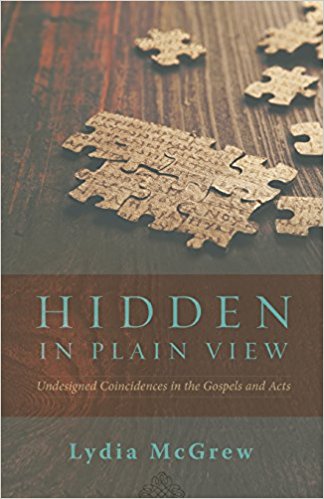Lyida McGrew is, according to her personal bio, a “homemaker, home schooling mom, analytic philosopher, and author.” She earned a a PhD in English Literature from Vanderbilt University in 1995. McGrew is the author of multiple articles on Christian Apologetics and philosophy and is the wife of well-known apologist, Tim McGrew. She is a member of St. Patrick’s Anglican Catholic Church. Hidden in Plain View is Lydia McGrew’s second book.
Hidden in Plain View (the book) is an analysis of what McGrew labels “undesigned coincidences” in the Gospels, Acts, and Pauline Epistles. McGrew defines an undesigned coincidence as “a notable connection between two or more accounts or texts that doesn’t seem to have been planned by the person or people giving the accounts. Despite their apparent independence, the items fit together like pieces of a puzzle.” (p. 12) The New Testament canon is full of such accounts; the Gospels, Acts, and the Pauline epistles were written by various authors about the life and times of the same people. McGrew contends that undesigned coincidences are apparent in the New Testament writings and provide good evidence that the various accounts of the lives of Jesus and the Apostles are historically reliable. Her book is an update of similar work done by Christian apologist, William Paley over two hundred years ago. In comparison to Paley’s work, McGrew is the beneficiary of two hundred more years of biblical scholarship.
Skeptical detractors of Christianity tend to focus on the apparent differences in the Biblical accounts. In doing so, they cast doubt upon the reliability of the New Testament. McGrew’s apologetic response is an interesting one. Rather than attempting to harmonize apparent biblical discrepancies (as other apologists have already done), McGrew focuses on the subtle similarities within the various New Testament accounts. These similarities, as analyzed and presented by McGrew, demonstrate that the biblical authors are more likely to have accurately reported on historical events than to have colluded to generate unhistorical falsehoods. McGrew’s work is both detailed and thorough. However, the book is not particularly theological; it is generally a-doctrinal. Readers looking for an explanation and defense of the Christian faith as a whole, won’t find that in Hidden in Plain View. Nor will readers find a defense of biblical innerrancy. McGrew’s concern in writing the book is to present an argument for biblical reliability. That’s exactly what she does. The book is very informative and would be a good resource in the library of any New Testament scholar, if only for its rich comparison of the biblical accounts. Those uninterested in “mere apologetics” in support of a “mere Christianity” will have little interest in the content of the book outside of its detailed review of the gospels and Acts. Much of the New Testament story is recounted in Hidden in Plain View and that is a story always worth reviewing and advocating.
[Contributed by: Seth Dunn]
*Please note that the preceding is my personal opinion. It is not necessarily the opinion of any entity by which I am employed, any church at which I am a member, any church which I attend, or the educational institution at which I am enrolled. Any copyrighted material displayed or referenced is done under the doctrine of fair use.











